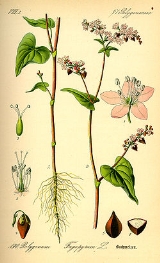
Buckwheat
Overview
Buckwheat refers to a variety of plants in the dicot family Polygonaceae
: the Eurasian genus Fagopyrum
, the North American genus Eriogonum
, and the Northern Hemisphere genus Fallopia
. Either of the latter two may be referred to as "wild buckwheat". Despite the name, they are not related to wheat, and are not cereals or grasses.
The cultivation of buckwheat grain, a pseudocereal
food crop, declined sharply in the 20th century in affluent regions where the usage of nitrogen fertilizer is popular.
The crop plant, common buckwheat, is Fagopyrum esculentum.
Polygonaceae
Polygonaceae is a family of flowering plants known informally as the "knotweed family" or "smartweed family"— "buckwheat family" in the United States. The name is based on the genus Polygonum and was first used by Antoine Laurent de Jussieu in 1789 in his book, Genera Plantarum. The name refers...
: the Eurasian genus Fagopyrum
Fagopyrum
The genus Fagopyrum in the flowering plant family Polygonaceae contains 15 to 16 species of plants, including two important crop plants, the Buckwheat or Japanese Buckwheat Fagopyrum esculentum, and the Tartary Buckwheat Fagopyrum tataricum. They have similar uses, and are classed as pseudocereals,...
, the North American genus Eriogonum
Eriogonum
Eriogonum is the scientific name for a genus of flowering plants, in the family Polygonaceae. The genus is found in North America and is known as wild buckwheat. This is a highly species-rich genus, and indications are that active speciation is continuing...
, and the Northern Hemisphere genus Fallopia
Fallopia
Fallopia is a genus of about 12–15 species of flowering plants in the family Polygonaceae, often included in a wider treatment of the related genus Polygonum in the past. The genus is native to temperate and subtropical regions of the Northern Hemisphere...
. Either of the latter two may be referred to as "wild buckwheat". Despite the name, they are not related to wheat, and are not cereals or grasses.
The cultivation of buckwheat grain, a pseudocereal
Pseudocereal
Pseudocereals are broadleaf plants that are used in much the same way as cereals . Their seed can be ground into flour and otherwise used as cereals. Examples of pseudocereals are amaranth, Love-lies-bleeding, red amaranth, Prince-of-Wales-feather, quinoa, and buckwheat.- Pseudocereals :...
food crop, declined sharply in the 20th century in affluent regions where the usage of nitrogen fertilizer is popular.
The crop plant, common buckwheat, is Fagopyrum esculentum.
Unanswered Questions
Discussions

